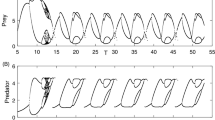Abstract.
A predator–prey interaction model based on a system of differential equations with temperature-dependent parameters chosen appropriately for a mite interaction on apple trees is analyzed to determine how the type of functional response influences bifurcation and stability behavior. Instances of type I, II, III, and IV functional responses are considered, the last of which incorporates prey interference with predation. It is shown that the model systems with the type I, II, and III functional responses exhibit qualitatively similar bifurcation and stability behavior over the interval of definition of the temperature parameter. Similar behavior is found in the system with the type IV functional response at low levels of prey interference. Higher levels of interference are destabilizing, as illustrated by the prevalence of bistability and by the presence of three attractors for some values of the model parameters. All four systems are capable of modeling population oscillations and outbreaks.
Similar content being viewed by others
Author information
Authors and Affiliations
Additional information
Received 12 March 1996; received in revised form 25 October 1996
Rights and permissions
About this article
Cite this article
Collings, J. The effects of the functional response on the bifurcation behavior of a mite predator–prey interaction model. J Math Biol 36, 149–168 (1997). https://doi.org/10.1007/s002850050095
Issue Date:
DOI: https://doi.org/10.1007/s002850050095




